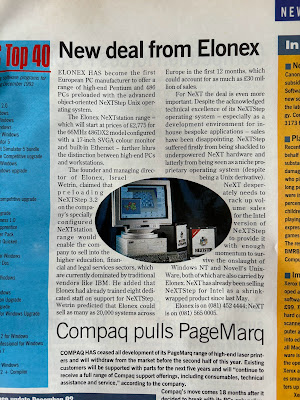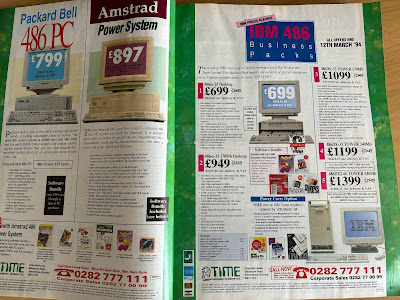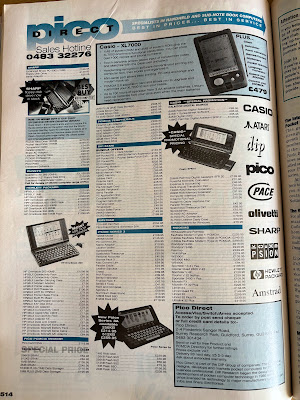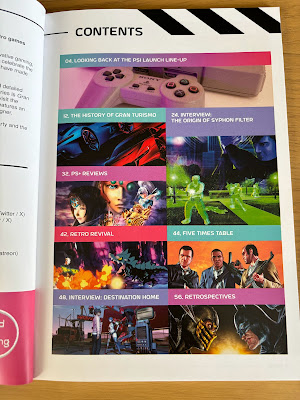This is more like it. Nobody wants a skinny computer magazine. They want great big back breaking telephone directory-style periodicals that not only inform and entertain, but can also be used in self-defence, either to hit someone with or to stop small calibre bullets. This, gentle reader, is the pinnacle of such publications - the one, the only, Computer Shopper (UK).
It's early 1994 and to all intents and purposes, the 386 is dead, long live the 486! The Pentium is faltering onto the stage albeit at prices that would make your eyes water, while portables are now most definitely mainstream as evidenced by the group test advertised on the front cover, pitting 21 of the mobile(ish) wonders against each other with a starting price of £799. But what else does this fine 600 page(!) issue have in store?
Quite a bit. The notebook test is front and centre but there are also group tests of presentation software and accelerator cards for Windows. Features cover music software, computers and the cops, and Super Computers. Don't get all excited though, the article merely discusses the architectural changes that were on offer and how they might affect future high performance computing. The usual departments are present and correct, as well as the format specific Shopper columns for Mac, Amiga, ST and Archimedes.
 |
| I keep reading the second story as Kenco... |
The first news piece reports an autumn release for Chicago. Aka Windows 4 (and eventually Windows 95), this replacement for 3.1 and Windows for Workgroups would see the big M put on its best razzle dazzle to hammer home the point that Windows PC's were for everyone. In other news, Elonex (remember them before they became a purveyor of cheap electronic trash before finally going bust?) were getting into the NeXTStep market with workstations running NeXTStep 3.2. A bold move (with even more bold sales targets of 20,000 machines across Europe in the first twelve months), it's no spoiler to say that it wasn't the success that they thought it would be. Two years later, Apple would buy NeXT to form the basis of what would become Mac OS X.
Speaking of Apple, they were about to launch their eWorld service. A gated community back in the early days of the web, it is the pricing structure that amuses more than anything else. For $8.95 per month, Apple would give you two free hours of use, with each subsequent hour costing $4.95. The very thought of paying by the hour to use the web! The past is a different country and all that...
Finally, there's news that Olivetti will become the sole European distributor of AT&T's EO 440 tablet. Larger than an Apple Newton (and that's saying something), this 10.8 x 7.1 x 0.9 inch device would set you back £1,999 then but at least offered a 7.5 inch mono display and a built in 14.4 modem.
 |
| EO, EO, work on the move with the built-in modem. |
To the cover group test and the rise of the truly useful portable PC. They do highlight the Amstrad alternatives (the NC200 being a handy desktop companion, although my preference was always for the NC100 as noted here), and you didn't need to spend megabucks on mobile productivity. In this group, only two machines managed to make it under the all important psychological £1,000 ex VAT barrier - the 386XL-powered Triumph Adler Walkstation 3/25 XL at £799, and the Mitac 4020F at £999. That £200 difference is telling, as the Mitac rocks a 25MHz 486 SX, double the RAM of the TA to 4MB whilst each pack an 85MB hard drive and mono display. Indeed, the Mitac gets the best buy. Other names you might reacll from the period include Watford Electronics with their Aries Perfecta 3300NB, AST's Bravo NB Color, Canon's BN22 BJ notebook with built in printer (those were the days, my friends), and Compaq's Contura 4/25C - still a lovely looking lappy!.
 |
| Handy company info included - and a helpful review layout. |
Hewlett Packard, Olivertti, Panasonic, IBM and Toshiba are other big names here, with big prices to match. Most of these machines include DOS (a couple don't, wanting something like £65 to £99 extra but they'll chuck in a mouse and Windows too), but even the budget TA includes DOS and Win as standard. Only four have 386 processors, the rest coming with a variety of Intel, Cyrix or Texas Instruments 486's. A couple offer 2MB of RAM, the rest provide 4MB, whilst mass storage ranges from 85MB to 200MB, the sole exception being HP's Omnibook 425 which has 10MB of flash storage. And as for colour, well, you'd need a good credit card or deep pockets - the cheapest dual-scan display is the Watford Perfecta's and that machine comes in at £1,500. Active matrix (faster refresh rate, little ghosting and far more vibrant) is epitomised by the Enta NB 6500T for £2,350, and they wanted another £99 for DOS and Windows!
The Shopper columns were always worth a read, and this issue proves no less entertaining. Amiga Shopper looks at Deluxe Music 2.0, coupled with a report on an Amiga party in Topeka Kansas, featuring the team from NewTek. If you remember Babylon 5 or seaQuest DSV, you'll know what their software could do. A Silica advert on the page opposite details the then current Amiga range and just how little you could spend to get an A600 for (if you actually wanted one). £189 for the base machine was really cheap, your bog-standard A1200 was £299 but with many more upgrade options, and the A4000 could be yours for £899, although a more usable configuration would be £999 - and then the monitor on top. You could buy a similarly spec'd Mac LC III for less. That's how competitive Commodore weren't by this point. Oh, and the CD32 was £289. Nice try, Commodore, but the Sony PlayStation would arrive in Japan that December and would easily demonstrate its superior technical chops.
Atari Shopper talks about the benefits of adding 8MB to an STE (more for use as a Ram disk than anything else), as well as talking about Geneva, a multi-tasking upgrade for Tos, whilst Archimedes Shopper looks at new Archie game Spheres of Chaos and a round up of news.
 |
| The Viglen range - they could have been Contenders... (badum tss!) |
It is, however, Macintosh Shopper that is the highlight. MacBiter casts a jaundiced eye over the announcement that Apple would move to the Power PC architecture. To say the author was a tad cynical about Apple's behaviour would be an understatement but he also had a point. No matter how much ill-will you had towards the fruity tinkers in Cupertino, you usually ended up shelling out for their kit anyway. And so it would prove...
 |
| Compaq Contura bottom left - a snazzy looking laptop, and the CDS to its right. |
As this is Shopper though, it is the adverts that take up most of the page count, as well as providing a handy guide to the state of the DOS/Windows market of the time.
As noted above, the 486 rules, with only a few hardy box sellers shipping 386 desktops (although 386 laptops are a tad more common). Reeves would happily sell you a 40MHz 386 SX with 2 meg of RAM and a 125MB hard drive for £539 ex. That doesn't include an operating system though. Watford Electronics would do you a similar 2 meg machine with a 170MB hard drive and a software budle for £735 ex.
Amstrad were still (just) in the market. Time Computer Systems offered a 486SX 25MHz model (4/214MB) for £897 ex VAT, which isn't bad but demonstrates that the once prolific budget box builder was now priced alongside almost every other clone maker out there. Hell, Time were clearing out IBM stock, with a 486 25MHz SX 2/85MB for £699 ex. Alongside IBM were the Ambra range of machines - Ambra being a consumer mail order focused spin off from IBM. Their Sprinta II range was competitively priced too - that ever so familiar 25MHz 486 with a 100MB hard drive for £799.
 |
| They look different, but they are from the same company. |
As you can tell, the 386 was your very budget option and very poor value for money considering the benefits of the 486, all the more so when you considered Multimedia! It was the future and there were numerous deals on adding CD-ROM drives. Compaq's Presario CDS625 all-in-one promised a tidy little set up (minus much in the way of expansion options) for £1,375, and it seemed to be that if you were canny enough, a CD-equipped 486 could be yours for just under a grand but really you needed to budget between £1k and 1.5K to get the most balanced set up.
Toshiba were still masters of the laptop market, featuring prominently with resellers, and even one or two of the latter were offering Macs - LC II's and 475's took care of the lower end of the market for £528 to £849 ex VAT from Novatech, while the more capable Quadra 610 and 650's allowed you to depart with a grand plus of your hard earned cash without a bother.
 |
| At this point, Amstrad were way off their game. |
Gateway was plugging its range of machines too - base 486SX 33MHz for £899, Pentium 60 for £1,999 and their non-too shabby looking Handbook 486 for £999. It's a canny looking portable.
 |
| Another dinky little laptop there. |
 |
| Is that a Lunar Gateway ad? NASA joke for you there, folks. |
Dabs Press were another popular reseller, and tucked away in their listing was the Amstrad Mega PC for £425 - by this point more a curio than a worthy PC/console hybrid. They did, however, offer a decent range of handhelds, and by those I mean Psions and the like. So too did Pico Direct, a retailer who made handhelds their speciality and offered a ton of difference devices.
Computer Shopper issue 73 shows the DOS/Windows PC at the pinnacle of its 486 journey. There were a growing number of resellers stocking big brands, and there were even more small box builders eager to eke out the thinnest of profit margins, yet it was also the time of decline for the traditional manufacturers too. The likes of Amstrad and IBM were slowly disengaging from the market, becoming just one of many names out there. As for the other computing formats, Atari was wasting away trying to support the Jaguar console and Acorn were making all the right noises but the wider changes to the PC market (multimedia and increasing power at decreasing prices) meant that its glory days were behind it. Apple was looking good, but the approaching launch of Windows 95 and the impression of PC superiority would hurt the company, almost as badly as the cack-handed corporate leadership and the on-going failure to modernise the OS. And as for Commodore, just three months after the publication date of this issue, ol'chicken lips would be bankrupt.
 |
| Against Amstrad, Olivetti's machines had a certain sense of style. |
It's always interesting looking at these old magazines. When taken as a whole, they not only inform you of what was happening at the time, but also add flavour to what you learn. Issue 73 was another cracking edition of the then most popular UK computing magazine, but for the next visit to yesteryear, we'll be heading back to the time of the launch of one of my favourite computer formats...
In the meantime, have a great festive/holiday period! I shall be back with more blogging shenanigans in the new year.








































